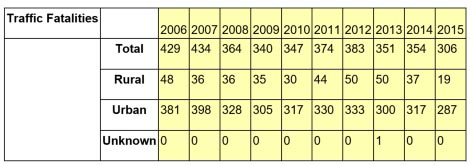Massachusetts Vehicle Fatality Crash Statistics
Over approximately the past 10 years, there has been a significant decline in motor vehicle fatalities in Massachusetts. In 2006, there were 429 total traffic fatalities, compared to 306 traffic fatalities in 2015, a 30% decrease.[1]
The number of fatalities in urban areas continues to greatly exceed the number of fatalities in rural areas. For instance, in 2015 (the latest year for which results are currently available from the US government) there were 287 fatalities in urban areas in Massachusetts, compared to 19 fatalities in rural areas.
While the total number of traffic fatalities decreased significantly in 2015 compared to 2006, urban areas saw only a 25% decrease during these two years, while rural areas saw a 47% percent decrease during these two years.
More information on total traffic fatalities in Massachusetts can be seen in the following chart:

Massachusetts Passenger Fatalities Continue to Decrease for Buckled Occupants
Fatalities also decrease during the 2006-2015 decade for buckled (restrained) vehicle occupants. In 2015, there were 172 vehicle occupant fatalities; 46 of them who were buckled, and 83 of whom were not buckled. (It was unknown whether the additional 43 fatalities were buckled or unbuckled).
In 2006, there were 300 fatalities; 79 fatalities involving buckled drivers, and 158 fatalities involving unbuckled drivers (it is unknown as to whether the balance of fatalities were buckled or unbuckled).
Buckling and Restraints Save Lives
In both 2006 and 2015 the number of unbuckled passengers who lost their lives was approximately double the number of buckled passengers.
According to one study, about 74% of passengers reported always using their seat belts in personal vehicles (i.e. non-taxis). Assuming that about 74% of Massachusetts passengers use seat belts, in the statistics above, the 26% of vehicle occupants who were not buckled account for about half of all fatalities, while the 74% who were are buckled account for the other half. These statistics thus add credibility to the proposition that seat belts save lives.
Air Bags are Also Contributing to Decreased Fatalities
Presumably, air bags also have contributed to the significant decrease in the loss of life over the 2006-2015 decade. While airbags were first developed in the 1970’s, it was not until the late 1980’s and early 1990’s that they became a standard feature in most cars. Since that time, air bag technology has significantly improved, and so has the way in which they are now used in vehicles, with “side curtains” and other configurations now being commonplace.
In 2006, a large portion of the population were likely driving vehicles that did not have air bags, or that had more primitive air bag designs. By 2015, few drivers were using vehicles without advanced air bag technologies.
We hope that all drivers and passengers will take the reasonable precautions for safe driving – buckling up, not driving drunk or impaired, and observing all laws.
More Information About My Traffic & Speeding Ticket Legal Matters:
- Hit-and-Run
- Traffic Tickets
- Speeding Ticket Lawyer
- License Loss
- Criminal Defense
- Texting While Driving
- Sleep Deprived Driving
- Drunk Driving, Traffic Offenses & Tickets
- Driving Without a License
- How Can a Drivers License Be Revoked in Massachusetts?
- Lowell Vehicle Crash Fatality Statistics
- Massachusetts Car, Truck & Vehicle Fatality Statistics
- Lowell Requirement for Report Submission for Vehicle Crashes
- Where are Lowell Vehicle Accident Cases Heard?
- Lowell, MA Speeding Ticket Lawyer
- Andover Injury Lawyer, Criminal Defense & OUI Attorney
- Billerica Injury Lawyer & Criminal Defense & OUI Attorney
[1] Information taken from the National Highway Transportation Safety Administration, https://cdan.nhtsa.gov/SASStoredProcess/guest

